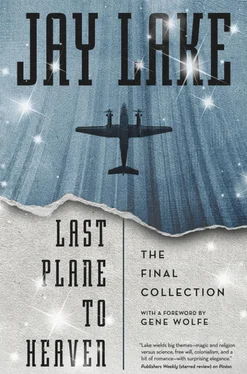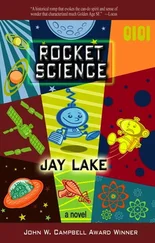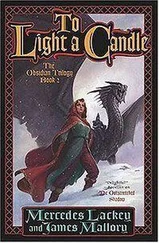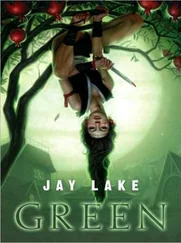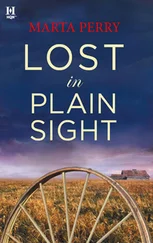This story arose out of a world-building exercise on a convention panel I’ve long since otherwise forgotten. We got into a discussion of superrotating atmospheres. I concluded they sounded like a lot more fun than they really are.
I wasn’t looking forward to dying lost and unremarked. Another day on Kesri-Sequoia II, thank you very much.
“Good morning, sir,” said Ensign Mallory from her navcomms station at the nose of our disabled landing boat. She was a small, dark-skinned woman with no hair—I’d never asked if that was cultural or genetic. “Prevailing winds down to just under four hundred knots as of dawn.”
“Enough with the weather.” I coughed the night’s allergies loose. Alien biospheres might not be infectious, but alien proteins still carried a hell of a kick as far as my mucous membranes were concerned. I had good English lungs, which is to say a near-permanent sinus infection under any kind of respiratory stress. And we’d given up on full air recycling weeks ago in the name of power management—with the quantum transfer chamber damaged in our uncontrolled final descent, all we had were backup fuel cells. Not nearly enough to power onboard systems, let alone our booster engines. The emergency stores were full of all kinds of interesting but worthless items like water purifiers, spools of buckywire, and inflatable tents.
Useless. All of our tech was useless. Prospero ’s landing boat smelled like mold. Our deck was at a seven-degree angle. We’d been trapped down here so long I swear one of my legs was shortening to compensate.
Mallory glanced back at the display. “I’m sure you know best, sir.”
* * *
Just under four hundred knots pretty much counted as doldrums on the surface of Kesri-Sequoia II. Since the crash we’d regularly clocked wind gusts well in excess of nine hundred knots. Outside the well-shielded hull of the landing boat Ensign Mallory and I would have been stripped to the bone in minutes. Which was too bad. Kesri-Sequoia II didn’t seem to be otherwise inimical to human life. Acceptable nitrogen-oxygen balance, decent partial pressure, within human-normal temperature ranges—a bit muggy perhaps. Nothing especially toxic or caustic out there.
It was the superrotating atmosphere that made things a bitch.
There was life here though, plenty of it—turbulent environments beget niches, niches beget species radiation, species radiation begets a robust biosphere. Just not our kind of life, not anything humans could meaningfully interact with.
Kesri-Sequoia’s dryland surface was dominated by giant sessiles that were rocky and solid with lacy air holes for snaring microbiota from the tumbling winds. They were a kilometer long, two hundred meters tall, less than two meters wide at the base, narrowing as they rose. The sessiles were oriented like shark fins into the airflow. Mallory called them land-reefs. We could see four from our windscreen, lightning often playing between them as the winds scaled up and down. Approaching one expecting communication would be like trying to talk to Ayers Rock.
Then there were ribbon-eels—ten meters of razor-thin color flowing by on the wind like a kootchie dancer’s prop. And spit-tides that crawled across the scoured landscape, huge mats of loosely differentiated proteins leaching nutrients from the necrophages that lurked in the surface cracks.
All surface life on Kesri-Sequoia II moved west to east. Nothing fought the winds. Nothing made me or Ensign Mallory want to get out and say hello. Nothing could help us get the landing boat back to orbit and the safety of Prospero . The atmosphere was so electrically messy we couldn’t even transmit our final logs and survey data to the crew waiting helplessly high above.
* * *
I stared out the crazed crystal-lattice of the forward portside viewport. I figured when something much larger than a pea hit it that was the end for us. Once the wind got inside the boat, we’d finally be dead.
A ribbon-eel soared by in the distance. The animal glittered like an oil slick as it undulated. “How strong do you figure those things are?” I asked Ensign Mallory. “They look like they’re made of tissue.”
She glanced at the exterior telemetry displays, seeing my eel with the landing boat’s electronic eyes. “I ran some simulations last week.”
“And?”
Mallory sighed wistfully. “I’d love to dissect one. Those things’ muscle fibers must have a torsional strength superior to spider silk. Otherwise they would shred in the turbulence.”
Her comment about spiders made me think of airborne hatchlings on Earth, each floating on their little length of thread. “I wonder if we could use some of those damned things as sails. If we could get the boat off the ground and pointed into the wind, we might be able to climb high enough on deadstick to at least get off a message to Prospero .”
They couldn’t send the other landing boat, prosaically named “B” to our “A,” after us. Not unless they wanted to condemn another crew. And our first touchdown had been so violent that even if we somehow found a way to power the engines there was no way we’d survive to the end of a second flight.
But getting our last words out had a certain appeal.
“How are you going to catch a ribbon-eel, sir? It’s not like we can step outside and go fishing.”
“Fishing…” I went back to the landing boat’s stores locker next to the tiny galley at the rear of the three-meter-long main cabin. Standard inventory included four spools of long-chain fullerene—buckywire, or more accurately, carbon nanotube whiskers grown to arbitrary macroscale lengths. In our case a rated minimum of a hundred meters per spool. That would be fishing line that tested out to a few hundred tons. “What do you figure ribbon-eels eat?” I asked over my shoulder as I grabbed the four spools.
* * *
We only had one local food available to us—the mold from the air ducts. Ensign Mallory scraped out a few cubic centimeters’ worth. It sat in the kneepad of our lone hardsuit like so much gray flour.
“This stuff won’t stick to anything, sir,” she said. Mallory’s voice was almost a whine. Surely she wasn’t losing her spirit now that we had something to focus on?
I considered the powdery mess. “Syrup packets from the galley. A little bit of cornstarch. We’re there.”
“How are you going to get it outside?”
“We’re going to build a little windlock on the inside of the busted viewport up front. Bind this stuff as a paste onto the buckywire, spool it out, and snag us a ribbon-eel.”
Buckybondo is weird stuff—it munges the electron shells of organic molecules. That’s the only way to stick fullerene-based materials to anything else. But you can glue your fingers to the bulkhead with it, literally bonding your flesh with the plastoceramics so that only an arc welder or a bone saw will cut you free. I wouldn’t let Mallory touch the stuff. We only needed a few drops in the mold paste to stick it to the buckywire. I figured I’d just suffer the risks myself. One of the burdens of command.
* * *
Two hours later I was playing out line through the windlock. The wind carried it away past my screen, out of my sight. I figured we’d significantly reduced the service life of the viewport by drilling the hole, but what else were Ensign Mallory and I going to do with the rest of our short lives?
“Slow it down, sir,” Mallory said. She monitored the sensors for ribbon-eels. “The wind is taking your bait too close to a land-reef.”
I thumbed the electrostatic brake on the buckywire reel. The line stopped extending. The buckywire made an eerie clatter against our hull as it vibrated in the wind.
Читать дальше
